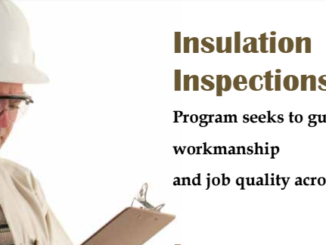
TIAC’s Innovators Group is hard at work revising and acquiring new technical documents to elevate the association and move the industry forward
By / Jessica Kirby
TIAC’s Innovators Group has a simple mandate—engaging young and new members to develop innovations that will help the association evolve and move the industry forward. In some ways that means implementing known solutions, such as technology and standards updates, and in other cases it means developing and implementing brand new solutions.
Luis Garcia, business development manager, insulation systems Eastern Canada, Johns Manville, says innovation, like many other subjective topics, finds its beauty in the eye of the beholder.
“Logic tells us that to innovate is to create something new, to disrupt,” he says. “However, some of the best innovations I have been a part of in my career have come from turning something already existing into a better business approach, a more effective go-to-market strategy, a faster solution, or a more efficient product.
“Whether working from an old or existing initiative or creating a new one, the art of innovation has no boundaries or pre-determined rules and that makes it very exciting,” he adds. “This is the reason why I joined the Innovators group at TIAC.”
Having a voice in the industry, particularly in the realm of technical documents like the Denis Formula and Best Practices Guide, was what brought Wayne Siffledeen, chair of the TIAC Innovators and project manager at Stuart Olson, to the table. During the contractors’ breakout session at the 2017 conference in Toronto, he raised the question of whether there were any plans to update the Denis Formula. It was a top of mind topic for the association but there was no initiative in place.
“That is what kind of sparked my involvement,” Siffledeen says. “Shaun asked if I would help spearhead that initiative, and that is where the innovators’s group originated.”
The most important impetus was having a voice and being active in bridging some of the gaps that exist in the industry. “For example, the Denis Formula is referenced and used in contractual agreements, but it is open to interpretation,” Siffledeen says. “The updates are looking to better clarify its terms and remove the ambiguity.”
Chris Yatscoff, senior vice-president with Reflex Manufacturing, Ltd., joined the Innovators for one simple reason: to help make the industry better. He also sees updating the technical documents as an important priority and brings a wealth of knowledge to that process.
“I am involved in the development and amendment of technical standards within certain ASTM task groups and have assisted numerous end users with their corporate standards regarding insulation blankets. The intent was to bring some of that experience to TIAC,” he says.
The updating process has not been without its challenges. Understanding the history and foundations of both documents has proven difficult with little information available. “We needed to establish how those documents were developed, where they come from, and whether any work has been done on them since their inception,” Siffledeen says. “The answers are still not clearly defined, which meant we had to start these initiatives from ground zero.”
Little is written on the origins of the Denis Formula. It was created in Calgary and applies mainly to large industrial projects and those in the natural resources sector. TIAC has used and referenced it and has tailored it to be more applicable to its projects.
“It may only be used by ten percent of our membership, but it is a driver for larger projects early in the engineering stages for establishing fixed unit rate prices,” Siffledeen says. “The Denis Formula says once you establish costs you can factor in the complexities of the system as you install them. It alleviates the risk for contractors to get measure-ups accounted for.”
Over the Innovators’ inaugural year, the group has worked on reviewing the documents to assess their capacity for updating and keeping current on a long-term bases. “The Best Practices Guide is dated and difficult to keep up-to-date in its current form,” Siffledeen says. “We have decided instead to move towards adopting the Midwest Insulation Contractors Association (MICA) manual that would eliminate the Best Practices Guide. We will retain the Denis Formula.”
The group has contacted MICA, submitted an RFP, and awaits a reply. “Bringing a new technical document to TIAC is very exciting,” Siffledeen says. “While we are waiting for that we are brainstorming the group for new ideas to gauge their input and direction.”
Siffledeen has more than 20 years in the industry during which time he has been focused on the insulation trade. “It is the ideas and experiences of our group and the ability to leverage the vast network of people we talk to regularly about these issues, including customers, suppliers, co-workers, and tradespersons, that will make our projects successful,” he says.
Another challenge in the industry in general is that it is constantly evolving, but the typical industry response is reactionary. “We really need to be proactive and on top of technology and innovation to secure the future of this trade and industry,” Siffledeen says. “Also, as a group we are all volunteers with limited availability and resources. We have to set goals that are achievable and not just be content working on something that takes several years. We need to be able to present and speak to our progress.”
Efrain Gutierrez attended TIAC’s annual meeting and conference in Toronto in 2017 and participated in National Insulation Association’s training program to obtain the Insulation Energy Appraisal Certificate.
“It was then when I realized the complexity of this industry,” he says. “Working in the industry, we face new challenges, and I can see there is always more work and research to be done. Knowing that a group was put together to address some of the needs of our industry, I found myself really interested in joining in order to learn and try to share my experiences.”
Gutierrez has a background in computer science engineering and feels confident he can bring new and creative ideas to the group. “I also have more than five years of work experience in the insulation industry and, of course, an Insulation Energy Appraisal certificate.”
Corrosion under insulation and thermal acoustic insulation are both opportunities and challenges in the mechanical insulation industry—and Gutierrez hopes the committee can work on progressive approaches to both in the group’s work. He also says involvement with the Innovators is a two-way street.
“It has been an excellent learning experience working with everyone in the Innovators Group and being able connect with individuals who have been working in this industry for many years,” he says.
Quality and compliance with standards offer some challenges and opportunities in mechanical insulation, particularly with how they relate to removable insulation blankets, says Yatscoff
“Many companies are willing to use materials that are of inferior quality, not in compliance with the insulation blanket standards established by engineers and end users, or fabricated using ineffective geometrical designs in order to secure new work,” he says. “These issues result in greater heat loss, piping and equipment freeze-ups, and systems not performing as they should.”
On account of these challenges, some end users have reduced the use of insulation blankets in both new construction and maintenance, thus shrinking members’ overall market potential, and calling for clarity to help regain this important market share.
“The opportunity for insulation blanket fabricators and insulation contractors is to gain a better understanding of and to ensure engineering and end user specifications are followed,” Yatscoff says. “Then, we can provide higher quality materials with a better fit and finish use that as a springboard for further acceptance of insulation blankets on projects and in maintenance.”
This is yet another example of how innovation is particularly important in the mechanical insulation industry—it brings together a tremendous amount of invaluable experience and expertise and combines it with new ideas and creative ways of keeping our industry in line with the times.
“The biggest benefit, and our goal as representatives of this innovation committee, is to put forward initiatives that directly help the industry,” Garcia says. “In the process, we’d aim to attract talent and leaders at all levels— owners, project managers, engineers, estimators, and insulators—who will support the insulation industry now and in the future.”
Garcia says the industry’s most important opportunity is to bring the end user community closer and get them more involved in mechanical insulation. “This community consists of engineers, specifiers, and any other business that has an impact on the value chain of construction,” he says. “If the end user consistently validates mechanical insulation and sees value in what it brings to their projects, this will have a positive trickledown effect on trades, contractors, distributors, and manufacturers.”
His goal is to bring a different perspective to some of the committee’s initiatives, leveraging his experience in different industries, such as building materials and construction, and at the same time be cognizant of and sensitive to the nuances and uniqueness of the mechanical insulation industry.
“As an innovation team, we complement each other’s skills and have a common goal to act in the best interest of the industry,” Garcia says. “I would like to think that my skill set, knowledge, and experience in similar industries, along with those of my peers on this team, provide for an ideal platform to innovate.”
James Lowe, Ideal Products, looks to the future and sees offsetting a rapidly aging workforce as the contruction industry’s biggest challenge and something all TIAC members will have to account for moving forward. Current population demographics show that the ideal work force age is 9% and 7% in Canada and the United States, respectively.
“Having the opportunity to help forge and cultivate the future of our industry in any way is a privilege,” he says. “I have typically been one who likes to challenge the status quo, and I feel that facing these challenges is going to take some of just that.”
In the next 10 years, Canada will see more than 1/5 of the construction labour force retire from the jobsite, taking with it priceless knowledge and experience. “All of that wisdom and experience will go along with that if we ignore it,” Lowe says. “Therefore I see one of the biggest opportunities of this committee is to address just that—the future.”
He hopes to build on experience garnered from involvement in other industry groups and committees and from working with a company that values innovation to help contribute to solving some of the major challenges underfoot.
“I feel the most important opportunities and challenges the industry holds are our rapidly changing dynamics of technology and labour force,” Lowe says. “The way we learn, grow, and communicate is very different than how we did just yesterday, thus we will have to adapt accordingly.
The group is looking at new training programs and speaker sessions for upcoming conferences and reaching out to other associations to create engagement with the membership. There is also discussion about a Corrosion Under Insulation Task Force, which will address increased awareness, discussion, and solutions to this problem.
As part of its on-going commitment and development, the Innovators welcome feedback and in many instances look for expertise and involvement from the membership on the initiatives it is exploring.
“We would like for everyone involved to become ambassadors of our industry, both in Canada and beyond,” Garcia says.
“What has been exciting and encouraging is receiving interest from other members who want to be involved with the Innovators Group,” Siffledeen says. “We need to bring new people in and out. People want to know what we are doing and have a voice.” ▪



